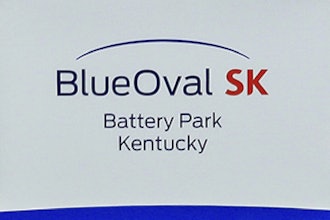
i n f o @ v i s t e x . c o m
Dave Hafermann
Principal, Go-to-Market/CRM Solutions
w w w. v i s t e x . c o m
Vistex white paper
Go-to-Market enablement of
your technology infrastructure
Go-to-Market programs are critical tools to
connect with customers and build profitable
relationships, but most companies do not
have the technology platform to properly
manage them.
This white paper shares Go-to-Market
building blocks, best practices and
strategies to achieve your ideal future state
Go-to-Market infrastructure.
In CloudOn-PremiseServicesSoftware
i n f o @ v i s t e x . c o m w w w. v i s t e x . c o m
Companies use Go-to-Market (GTM)
programs to connect with their customers
and build profitable relationships. Yet most
companies do not have a platform to properly
manage these programs, and are forced to
patch together different technologies to
create a workable solution.
You likely already use a combination of Enterprise
Resource Planning (ERP) and Customer Relationship
Management (CRM) systems to run your business.
ERP software manages and automates back office
functions for finance, accounting, human resources,
manufacturing and production, distribution and
supply chain, services and human resources. And CRM
supports sales, marketing and customer service. But
what technology should you use to support Go-to-
Market programs? The complexity of rebate, reward
and MDF & Co-op programs, as well as billbacks and
chargebacks, is staggering when you consider all the
parties these programs incentivize and support. So,
it is crucial to have the right technology in place to
manage these intricate and often complex programs.
This white paper defines the building blocks of a
GTM platform, shares best practices to help you
integrate GTM technology with your existing CRM
and ERP systems, and shows you how to develop a
roadmap to guide you from your current to future
state infrastructure.
Why GTM Programs Need More than CRM
and ERP
Go-to-Market refers to the set of tactics used to
connect customers with the organizational processes
necessary to guide customer interactions from
initial contact through fulfillment. In other words,
GTM Programs are the vehicles by which the value
proposition is delivered, and typically describe the
product portfolio, as well as how, where and to
whom the portfolio will be promoted. GTM programs
typically follow a standard lifecycle, and require
support of the following business processes:
As the table below shows, ERP and CRM platforms
do not address the business processes that support
2
Go-to-Market Technology Infrastructure
GTM Business Processes ERP Coverage CRM Coverage
Planning & Budgeting Low N/A
Program Communication – promoting the program to
potential participants
N/A Medium
Participant Management – who is eligible N/A Low
Activity Capture – what source(s) of data are used to
measure performance
Medium Low
Performance Calculation N/A N/A
Performance Reporting – to program participants N/A Low
Settlement – fulfillment of the program or incentive High N/A
Measurement – determining whether or not the program
achieved its objectives
N/A Low
i n f o @ v i s t e x . c o m w w w. v i s t e x . c o m
3
GTM programs. To get this coverage, you must choose
between building a standalone solution, searching
for off-the-shelf solutions, customizing your ERP or
CRM platforms or continuing to run programs using
spreadsheets – all of which present challenges:
■Build: Expensive option with lengthy
development cycles. And once built, IT is
usually unable to implement marketing’s
ever-evolving creative program
strategies in a timely manner.
■Buy: You will need to integrate various
GTM applications – likely from multiple
vendors
■ Spreadsheets: Lack of ability to scale,
subject to manual errors, lack of controls
and inability to operationalize.
Compounding the matter, GTM programs rely on
master data that lives in ERP, CRM and other external
systems, so integrations can be problematic. Also,
giving customers and supply chain partners visibility
into programs is challenging because ERP and
CRM licensing models make it expensive to support
hundreds or thousands of external users. As a result,
many GTM programs are not well-communicated or
made visible to those who need them the most.
So what should you do to support Go-to-Market
programs? First, you need to understand the
essential GTM building blocks.
GTM Infrastructure Building Blocks
Extending your existing technology to support GTM
programs can be complex. The first step is to focus
on the foundation upon which every effective GTM
infrastructure is constructed:
■ GTM Data Model
■ Customer Portal
■ Integration Framework.
■ GTM Program Applications
GTM Data Model
GTM programs are data-driven. Therefore, it’s
important your data model is structured to deliver
a 360-degree view of customers and partners. A
complete GTM Data Model will provide your account
and program managers with the information they
need to effectively manage assigned accounts,
measure customer value and gauge performance
of GTM programs. It is also the foundation for
delivering relevant, targeted content, benefits and
communications to customers and partners
The GTM Data Model should be implemented on your
CRM platform because CRM provides many of the
necessary data objects (collections of similar, related
information), as well as the tools to track, manage
and maintain your data. However, there are several
considerations and extensions required to effectively
support GTM Programs.
Customers at the Center
Customers are the focal point of CRM. The CRM
Account manages customer and partner profiles,
and should be at the center of the data model. But
in order for it to work correctly, you will need several
standard extensions to the CRM Account to keep
profiles accurate and complete.
■The Golden Account: Account master
data is best managed within a Master
Data Management (MDM) system, which
Go-to-Market Technology Infrastructure
i n f o @ v i s t e x . c o m w w w. v i s t e x . c o m
4
is a common component of ERP. Account
records from CRM must be “synced”
with MDM for validation, de-duplication,
hierarchy assignment and enrichment
from external data sources such as Dun
& Bradstreet. Once this data is synced,
the CRM Account becomes the single
source of truth for customer profiles
used by your GTM programs.
■Control Attributes: These are used
to manage system-level access and
business processes that act on Accounts.
Standard attributes include type of
Account (customer, partner etc.), record
status (active, inactive) and lifecycle
stage (e.g. suspect, prospect, customer).
■Business Profile Attributes: Attributes,
such as company size, verticals served
and others used by sales and marketing
to describe and segment customer
Accounts.
■Global Tiering and Segmentation Model
(GTSM): This defines the set of standard
attributes consistently used across the
organization to classify customers and
partners for purposes of entitlement,
program eligibility, reporting, and
access to relevant portal content, tools
and other resources. Established best
practices suggest limiting attributes to a
manageable set of five to 10.
GTM Program Framework
The GTM Program Framework brings visibility of
GTM programs into CRM, providing an enormous
benefit to your sales and marketing teams. The
ability to view and interact with this information in
CRM offers many benefits, including:
■Easy management of eligibility and
enrollment to your GTM Programs
■Tracking of program performance
in aggregate and by Account, which
improves visibility and forms the basis
for program analytics
■An audit trail of program participation
supporting compliance tracking
■CRM dashboards and reports that
combine GTM program data with CRM
profiles and other activity, to provide
deeper insight
■Ability to leverage CRM workflow
for program approvals and CRM
communication templates for
communicating with participants
■Program budget tracking
You want the benefits above, but you also need
a structure to deliver them. There are variations
on structure, but a basic implementation always
includes these additions to CRM:
■GTM Program provides a master
definition of each GTM program,
including dates, terms, requirements
and benefits
■Account Program is the intersection
between the Account and the GTM
Programs that enables account and
program managers to view and manage
program eligibility for each customer.
It also tracks program enrollment,
Account
GTM Program
Performance
TransactionAccount Program
Go-to-Market Technology Infrastructure
i n f o @ v i s t e x . c o m w w w. v i s t e x . c o m
5
participation and performance, which
are all prerequisites for program
analytics.
■Performance Transaction tracks
performance activity of each participant
against the program. For example, for a
growth rebate this provides a summary
of eligible sales activities for each
Account and reporting period.
Rounding Out the Data Model
More than an Account profile is needed for a
comprehensive view of a customer’s interactions
with your organization. You need additional objects
to manage information such as Contacts, Leads,
Opportunities, Quotes, Contracts, Customer Service
Cases, Certifications, Specializations, Attachments
and more. The good news is CRM provides many of
these out of the box, along with tools that make it
easy to extend or customize the GTM Data Model so
that you can build that comprehensive view.
Customer Portal
A customer or partner portal is the primary means
by which customers interact with your company, so
you want it to be as easy and as helpful as possible.
It should embody everything you want customers
to associate with your company, because it will
influence their perception of you and your programs.
As such, an effective portal clearly delivers the value
proposition to customers and partners, and makes it
easy to participate in your Go-to-Market programs.
This can be challenging though, if you have multiple
web properties supporting different divisions, regions,
standalone applications and tools.
Partners and customers alike often complain of
stale content on portals, cluttered pages and clumsy
navigation that makes finding information difficult.
Avoid these common complaints by focusing on these
tips:
■Provide an intuitive, easy user
experience: Use a clean design, and apply
the “three-click” rule to enable users to
find what they need quickly.
■Create a profile-driven user experience:
Leverage the data in your CRM profiles
to streamline and personalize each user’s
experience. It can also be used to manage
role-based security controls access for
GTM programs, resources and content.
■Consolidate multiple web properties
into one portal: Partners and customers
have limited time, so you have to make
interacting with your portal quick and
easy. Offer one portal with single sign-
on for a seamless experience, consistent
branding and fast access to content, tools
and resources.
■Highlight GTM program Information:
Help customers understand the benefits
they receive and the programs for which
they are eligible, using personalized GTM
benefit and membership statements.
■Cultivate community and collaboration:
Empower users to share experiences
through content ratings and support
communities. Interaction cultivates good
ideas and knowledge transfer that benefits
users, but also gives you insight into what
is working well and what should change.
■Mobilize: Make sure the portal UI is
optimized for mobile, offering anytime/
anywhere access.
■ Leverage your Content Management
System: Keep your content up to date by
authorizing content creators to author
and publish content directly to the portal
without IT involvement.
■Bring the portal to life: Keep your
portal dynamic and relevant with pre-
built widgets and controls that highlight
features, such as recent, trending, and
highly rated content, task lists and
dashboards.
Go-to-Market Technology Infrastructure
i n f o @ v i s t e x . c o m w w w. v i s t e x . c o m
6
Integration Framework
Do changes to your GTM programs take too long and
cost too much? Do you have siloed data and multiple
versions of the truth? Do your customers need to
remember multiple passwords to access various GTM
program benefits? Does your current technological
environment limit your ability to deploy the types of
GTM programs and tools you need?
If you answered yes to any or a combination of
these questions, then you likely are having trouble
with integration – and more specifically, unique
integration points. Integration points occur anywhere
data is exchanged between systems – including user
interfaces, databases, synchronization processes and
data imports. They cause accumulation of technical
debt – growing complexity, data redundancies,
additional dependencies and creation of exceptions –
that waste IT resources, create errors and make audits
nearly impossible. The more integration points you
have the more of these issues you will experience.
There is a better way. A standards-based integration
framework prevents these challenges, enabling
you to seamlessly integrate tools and services for
customers, without creating “islands” of data or
incurring ever-escalating integration and maintenance
costs. The framework minimizes the number of
unique integration points, provides the flexibility to
accommodate evolving GTM requirements and gives
you the ability to plug-in solutions from internal and
third-party providers – the technical equivalent of
“plug-and-play.”
Implementing a standards-based integration
framework requires you to:
1. Establish one system of record for each
data point.
2. Utilize standard single-sign-on to
authenticate portal users and associated
programs, tools and applications.
3. Provide a web service to enable affiliated
applications to share core partner profile
data from CRM.
4. Implement a standard GTM Program
Framework used by all affiliated GTM
applications to synchronize program and
performance information in a consistent
manner.
GTM Program Applications
The final building block is the GTM Program applications
that power your programs. These applications need
to be connected to your GTM Data Model and your
Portal using an Integration Framework as described
above. If your organization is like most, you have a mix
of internal and third-party GTM applications. Perhaps
a few of them meet your needs, but surely others do
not – and it’s important for you to address the ones
that are falling short.
Because GTM programs are not well supported by ERP
or CRM platforms, you are faced with the classic build
vs. buy decision, and there are pros and cons for each
as outlined earlier. However, given the availability of
third-party solutions, the best choice, generally, is to
buy rather than build. There are a few vendors, such
as Vistex, that provide comprehensive GTM suites but
most solutions manage only a single aspect of a GTM
program. While a GTM suite provides you with the
most complete capabilities and offers a path toward
standardizing on a single GTM platform, the good news
is that with a solid Integration Framework, a multi-
supplier model can be supported with acceptable
levels of incremental technical support.
How Should I Proceed?
In an ideal world you could build your technology
platforms from the ground up, making sure each
GTM Building Block is right before proceeding. You
would ensure your data model, portal and integration
framework incorporated the best practices shared
in this paper. However, unless your organization is a
start-up, this is a luxury few companies can afford.
Go-to-Market Technology Infrastructure
i n f o @ v i s t e x . c o m w w w. v i s t e x . c o m
7
Most organizations will need to retrofit their existing
technology environment while keeping the business
running. The only way to navigate this challenge is to
create a roadmap to take you from your current state
to your desired future state.
Before beginning this exercise, make sure you
have a clear definition of your GTM program
requirements. Your first step will be to assess
your current technology environment, taking into
account your portal technologies, data model and
other points for integration, such as your GTM
applications and operational data stores. Part of
this step includes identifying of all your integration
points and establishing a clear picture of your current
environment. With this in place, you can define your
future state environment, which should reflect the
best practices shared in this paper.
With a comprehensive assessment of your current
and future states, you will be able to identify the
delta between the two by performing a Gap Analysis.
You can then organize the gaps into discrete projects
prioritized by pay-off, effort level and dependencies.
The roadmap should cover a one- to three-year
planning horizon, and should begin delivering
incremental benefits within 90 days so that the
business begins to recognize incremental value
quickly.
And in the End...
Running global GTM programs is a complex endeavor,
and success depends upon your ability to understand
customers and partners well enough to deliver the
right GTM Programs, and in a way that enables them
to grow their business. Having the right GTM-enabled
infrastructure constructed upon the four main
building blocks is essential for success. By applying
the design principles outlined in this paper, and armed
with a solid roadmap and organizational commitment
to follow-through, you can achieve game-changing
results.
■ Assess current
Go-to-Market
strategy & program
environment
■ Document current
state Go-to-Market
Program
■ Define future
state environment
based on best
practices
■ Gaps, obstacles
■ Opportunities
■ Recommendations
■ Op High-level
roadmap
Go-to-Market Technology Infrastructure
w w w. v i s t e x . c o m
Solution Sets
■Program Strategy
■Analytics
■ Implementation
■Post-Production Support
■Training
■Global Payments
■Program Administration
Services
i n f o @ v i s t e x . c o m
■Contracts
■Pricing
■Rebates
■Benefits
■Trade & Channel
■Rights & Royalties
■Performance Management
■Payment
Make More. Keep More. Grow Smarter.
In CloudOn-PremiseServicesSoftware
About Vistex
Vistex provides enterprise solutions that manage pricing, incentive, rebate, royalty and channel programs to enhance
business performance while reducing labor and infrastructure costs. The industry-optimized Go-to-Market Suite®
provides end-to-end solutions for design, management and administration of the complete spectrum of programs. With
an unparalleled offering of software and services, enterprises are empowered with unprecedented visibility into program
performance, gaining deeper insights to better enable fact-based decisions that drive revenue, control cost, minimize
leakage, and streamline processes.
Vistex®, Go-to-Market Suite®,ViZi®, and other Vistex, Inc. graphics, logos, and service names are trademarks, registered trademarks or trade
dress of Vistex, Inc. in the United States and/or other countries. No part of this publication may be reproduced or transmitted in any form or for
any purpose without the expressed written permission of Vistex, Inc. The information contained herein may be changed without prior notice.
© Copyright 2015 Vistex Inc. All rights reserved.






















